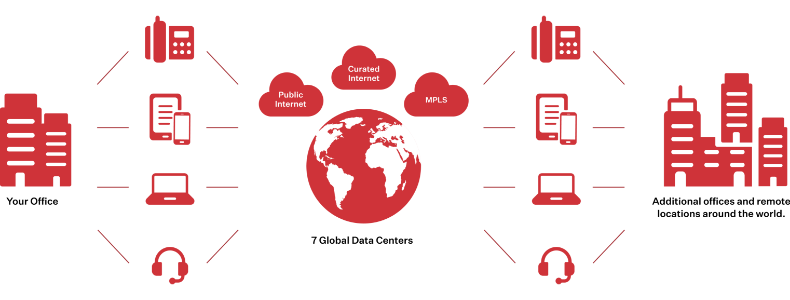What is SIP (Session Initiation Protocol) trunking and why do you need it?

Businesses today require more than just dial tones to communicate successfully; they demand efficient, scalable and cost-effective communication solutions. One crucial player in modern business phone systems is SIP trunking, which has revolutionized how organizations communicate. But what is SIP trunking and why exactly do you need it?
To help you make the best decision for your organization, we’re diving into the details of SIP trunking, exploring its features, benefits and what you need to consider before committing to SIP trunking. First up, let’s get into the nitty-gritty of what SIP trunking is.
What is SIP trunking?
To explain what SIP trunking actually is, we’ll break it down word by word.
SIP, or Session Initiation Protocol, is a set of formatting rules for initiating, maintaining, modifying and terminating real-time communication sessions over the internet, including voice calls, video calls, messages and more. In short, it’s the technology that makes it possible for different communications devices and applications to “talk” to each other over the internet.
Now, what is a SIP trunk? The term “trunking” refers to the method of combining multiple communication signals or channels into a single, high-capacity line or link. Picture a tree where multiple branches are united by a single trunk. In the case of SIP trunking, the trunk is what connects a PBX’s numerous lines to the public switched telephone network.
Putting it all together, SIP trunking is a modern telecommunication solution that uses the internet to virtually connect PBXs to the public switched telephone network (PSTN), enabling internet telephony.
SIP Trunking and PBXs
Ultimately, you can’t really discuss SIP trunking without also talking about PBXs. So, what’s the connection?
To start, a PBX, or Private Branch Exchange, is a private telephone network used within an organization. The PBX is what allows internal users to make calls to each other and, when connected to the PSTN, make external calls to anyone outside of the private network. Think about hotel phones that let you call the front lobby and make an external call to a friend.
Traditionally, PBXs were connected to the PSTN using physical lines. SIP trunking modernizes this by sending your PBX to the cloud. If your business has an existing on-premise PBX system, SIP trunking can be used to connect that system to the internet and turn it into a cloud-based phone system. This allows a business to leverage VoIP capabilities, including making and receiving calls over the internet.

What’s the difference between VoIP and SIP trunking?
Often tossed around in the same conversations, the question of VoIP vs. SIP is common. Essentially, VoIP is a broader term that encompasses different technologies for internet-based voice communication while SIP is a specific protocol within the VoIP framework. In other words, SIP trunking falls under the umbrella of VoIP.
Benefits of SIP trunking
When compared to traditional telephony systems, SIP trunking stands out for its benefits.
Traditionally, businesses used PRI (Primary Rate Interface) trunking, which relied on physical lines to establish connections between the PBX and the PSTN. Each line provided a fixed number of voice channels (typically 23), making it much less flexible and scalable in comparison to newer alternatives.
On the other hand, SIP trunking takes a more virtual approach by making this connection over the internet. This fundamental shift brings about numerous advantages, from cost savings to enhanced flexibility.
Here are five benefits that make SIP trunking a powerful choice for modern businesses.
1. Cost savings. One of the biggest reasons businesses adopt SIP trunking is the substantial cost savings it brings to the table. By saying goodbye to traditional phone lines, organizations can cut hefty expenses associated with maintaining outdated infrastructure.
SIP trunking is also a particularly attractive option for businesses with a global presence. Its use of the internet effectively reduces or eliminates long-distance charges, enabling companies to seamlessly connect with clients and partners globally without breaking the bank.
2. Scalability. The dynamic nature of business requires communication systems that can adapt on the fly. With SIP trunking, scaling a system up or down becomes a quick and hassle-free process. Organizations are able to easily add or remove lines to get the exact number they need, rather than being constrained to multiples of 23.
This flexibility is particularly beneficial for growing businesses, as they can expand their communication infrastructure without the hassle of waiting for physical line installations or the headache and costs of overhauling the entire system.
3. Flexibility. SIP trunking is flexible in that it can integrate with various communication systems. From traditional phone systems to advanced unified communication platforms, SIP trunking plays well with others.
Whether videoconferencing, instant messaging, or connecting traditional voice calls, SIP trunking can support all kinds of communication. This flexibility lets businesses choose the communication tools that fit their needs and integrate them into a cohesive and efficient system. As a result, employees can seamlessly switch between voice, video and messaging platforms, promoting collaboration and efficiency across the board.
4. Greater global reach. SIP trunking gives businesses the freedom to operate from anywhere. In being able to establish virtual phone numbers in different regions, organizations can create a local presence without the need for physical offices.
This geographic flexibility is particularly beneficial for companies with a global customer base or those looking to expand into new markets. By creating virtual offices in different locations, businesses can reach more customers, improve customer accessibility and strategically position themselves in diverse markets.
5. Reliability and disaster recovery. SIP trunking also improves the reliability of communication services and can help with disaster recovery.
Traditional telephone lines can easily be physically damaged or knocked out by outages or natural disasters, which can disrupt communication. In contrast, SIP trunking leverages the reliability and redundancy of internet connections so there’s less risk of service interruptions.
In addition, SIP trunking allows businesses to easily set up disaster recovery plans by automatically rerouting calls to alternative locations or backup systems in the event of an outage. This ensures that businesses can continue to communicate even during unexpected disruptions, safeguarding operations and keeping customers happy.
All in all, the adoption of SIP trunking is more than a technological upgrade; it’s a strategic move toward a future-proof communications system. As you explore the possibilities of SIP trunking, consider the unique needs of your organization and how this technology can propel you toward a more connected and efficient future.
What to consider before choosing SIP trunking
Before implementing SIP trunking, there are key considerations that can make or break your experience. While SIP trunking can be a game-changer, a thoughtful approach is essential to ensure a seamless transition. Here are some things to take stock of before taking the leap:
Technical requirements and compatibility
First, you’ll want to ensure that your current infrastructure is compatible with SIP trunking.
Start with assessing your network. SIP trunking relies heavily on a stable and strong internet connection. Inadequate network resources can lead to call quality issues, dropped calls and potential security vulnerabilities. Evaluate your network bandwidth, latency and overall capacity to ensure it can handle the traffic efficiently.
Quality of Service (QoS) is another important factor. Implementing QoS measures helps prioritize SIP traffic, ensuring that voice and video data receive the necessary bandwidth for optimal performance. This guarantees a smooth and reliable communication experience for your users, preventing issues like dropped calls or laggy video conferences.
Additionally, consider your existing systems and hardware, such as your PBX. While most PBX systems can be used with SIP trunk service, older PBXs may need to be upgraded or replaced.
Regulatory compliance
Know that SIP trunking may be subject to specific regulations and compliance requirements depending on your geographical location and industry. Take time to get caught up on the relevant legal requirements related to voice communication, such as:
- Emergency service access. Your system must be capable of routing emergency calls to the appropriate authorities. In the United States, this means that SIP trunk providers must be compliant with the Federal Communications Commission’s (FCC) Enhanced 911 regulations.
- Data retention. Providers may be required to retain call data for a certain period of time. This is typically required for compliance with laws related to fraud prevention, customer service and security.
- Privacy laws. You and your provider must comply with all applicable privacy laws, such as laws related to the collection, use and disclosure of personal information.
Remember, regulatory requirements can vary significantly from one jurisdiction to another, so consider consulting with a legal advisor to determine the specific requirements that apply to your organization.
SIP trunking provider evaluations
Choosing the right SIP trunking provider is a critical decision so be sure to carefully evaluate potential vendors. A good place to start is by researching the provider’s reputation in the industry. Look for reviews and testimonials from other customers to gauge the vendor’s track record and reliability.
Also check the level of customer support the provider offers. Can they be contacted via phone, chat, email or more? What are their hours of support? You want a provider that offers fast, reliable support when you need it.
Before finalizing your choice, carefully review the service-level agreements (SLAs) offered by the SIP trunking provider. SLAs outline the provider’s commitment to uptime, support and performance guarantees. Knowing these terms will help you make sure your expectations match the provider’s capabilities.
Transition process
As with any change, there will be a transition process that may temporarily impact your operations. While your SIP trunk provider should work with you to build a plan that has minimal disruption to your organization, it’s helpful to be aware of the potential areas of impact.
For instance, there may be a period when your phone system is offline as the necessary changes are made to your network and to connect your SIP trunks to your phone system. The amount of downtime will vary depending on the complexity of your phone system. Ask if the transition can occur at a time that’s convenient for your business.
Additionally, there may be a learning curve for using the new system, leveraging advanced functions and troubleshooting problems, depending on your and your team’s baseline knowledge and the extent of the changes.
Here are some tips to help ensure your transition to SIP trunking causes minimal disruptions to your business:
- Plan ahead. Collaborate closely with your SIP trunking provider to develop a comprehensive transition plan. This plan should outline the specific steps involved in migrating to SIP trunking and establish a clear timeline for each phase.
- Communicate with your team. Keep your employees well-informed about the upcoming changes, such as the reasons behind the transition, its benefits and how it may impact their daily tasks.
- Test your new system. Once your system is up and running, test it to make sure it is working properly. By thoroughly evaluating the new system, you can catch and resolve any glitches before fully deploying it for day-to-day operations.
- Provide training for your team. If necessary, train your team how to operate the new system. This proactive approach minimizes disruptions in the transition, helping your team adapt to any changes with ease.
By following these tips, you can help to ensure that the transition process is smooth, efficient and successful. For more information on how your business can maximize its SIP investment, check out our SIP best practices.
Get started with Session Initiation Protocol trunking
In a nutshell, SIP trunking is a game-changer for today’s communication needs. It gives businesses the kind of phone system they dream of—efficient, easy to scale and budget-friendly.
We’ve covered a lot about SIP trunking, from what it is to how it works with PBXs. The perks are also hard to ignore, from big savings to giving organizations the flexibility to grow. So before you take the leap, make sure your tech is compatible, you understand the rules, you pick a solid SIP partner and plan for a smooth switch. Ready for a phone system upgrade? Ooma can help you get started with SIP and IP trunking today.

Learn more about how Ooma Office can help your business.
Thank you!
An Ooma Office Sales Representative will be in touch shortly.
866-573-0707


Learn more about how Ooma Office can help your business.
Just call 877-621-0515 or click this to CHAT. Or, fill out this form and someone will reach out to you shortly.



